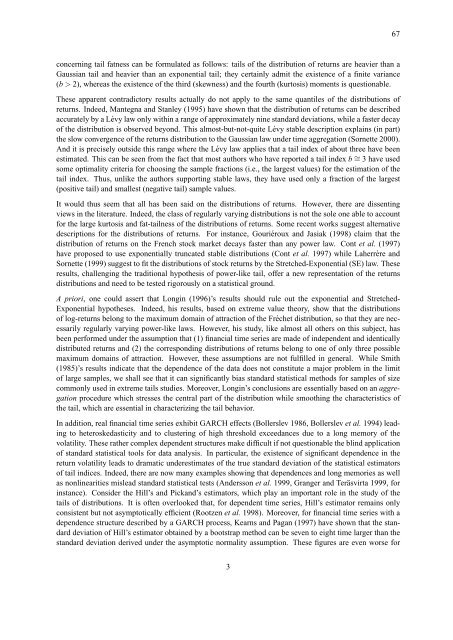statistique, théorie et gestion de portefeuille - Docs at ISFA
statistique, théorie et gestion de portefeuille - Docs at ISFA
statistique, théorie et gestion de portefeuille - Docs at ISFA
You also want an ePaper? Increase the reach of your titles
YUMPU automatically turns print PDFs into web optimized ePapers that Google loves.
concerning tail f<strong>at</strong>ness can be formul<strong>at</strong>ed as follows: tails of the distribution of r<strong>et</strong>urns are heavier than a<br />
Gaussian tail and heavier than an exponential tail; they certainly admit the existence of a finite variance<br />
(b > 2), whereas the existence of the third (skewness) and the fourth (kurtosis) moments is questionable.<br />
These apparent contradictory results actually do not apply to the same quantiles of the distributions of<br />
r<strong>et</strong>urns. In<strong>de</strong>ed, Mantegna and Stanley (1995) have shown th<strong>at</strong> the distribution of r<strong>et</strong>urns can be <strong>de</strong>scribed<br />
accur<strong>at</strong>ely by a Lévy law only within a range of approxim<strong>at</strong>ely nine standard <strong>de</strong>vi<strong>at</strong>ions, while a faster <strong>de</strong>cay<br />
of the distribution is observed beyond. This almost-but-not-quite Lévy stable <strong>de</strong>scription explains (in part)<br />
the slow convergence of the r<strong>et</strong>urns distribution to the Gaussian law un<strong>de</strong>r time aggreg<strong>at</strong>ion (Sorn<strong>et</strong>te 2000).<br />
And it is precisely outsi<strong>de</strong> this range where the Lévy law applies th<strong>at</strong> a tail in<strong>de</strong>x of about three have been<br />
estim<strong>at</strong>ed. This can be seen from the fact th<strong>at</strong> most authors who have reported a tail in<strong>de</strong>x b ∼ = 3 have used<br />
some optimality criteria for choosing the sample fractions (i.e., the largest values) for the estim<strong>at</strong>ion of the<br />
tail in<strong>de</strong>x. Thus, unlike the authors supporting stable laws, they have used only a fraction of the largest<br />
(positive tail) and smallest (neg<strong>at</strong>ive tail) sample values.<br />
It would thus seem th<strong>at</strong> all has been said on the distributions of r<strong>et</strong>urns. However, there are dissenting<br />
views in the liter<strong>at</strong>ure. In<strong>de</strong>ed, the class of regularly varying distributions is not the sole one able to account<br />
for the large kurtosis and f<strong>at</strong>-tailness of the distributions of r<strong>et</strong>urns. Some recent works suggest altern<strong>at</strong>ive<br />
<strong>de</strong>scriptions for the distributions of r<strong>et</strong>urns. For instance, Gouriéroux and Jasiak (1998) claim th<strong>at</strong> the<br />
distribution of r<strong>et</strong>urns on the French stock mark<strong>et</strong> <strong>de</strong>cays faster than any power law. Cont <strong>et</strong> al. (1997)<br />
have proposed to use exponentially trunc<strong>at</strong>ed stable distributions (Cont <strong>et</strong> al. 1997) while Laherrère and<br />
Sorn<strong>et</strong>te (1999) suggest to fit the distributions of stock r<strong>et</strong>urns by the Str<strong>et</strong>ched-Exponential (SE) law. These<br />
results, challenging the traditional hypothesis of power-like tail, offer a new represent<strong>at</strong>ion of the r<strong>et</strong>urns<br />
distributions and need to be tested rigorously on a st<strong>at</strong>istical ground.<br />
A priori, one could assert th<strong>at</strong> Longin (1996)’s results should rule out the exponential and Str<strong>et</strong>ched-<br />
Exponential hypotheses. In<strong>de</strong>ed, his results, based on extreme value theory, show th<strong>at</strong> the distributions<br />
of log-r<strong>et</strong>urns belong to the maximum domain of <strong>at</strong>traction of the Fréch<strong>et</strong> distribution, so th<strong>at</strong> they are necessarily<br />
regularly varying power-like laws. However, his study, like almost all others on this subject, has<br />
been performed un<strong>de</strong>r the assumption th<strong>at</strong> (1) financial time series are ma<strong>de</strong> of in<strong>de</strong>pen<strong>de</strong>nt and i<strong>de</strong>ntically<br />
distributed r<strong>et</strong>urns and (2) the corresponding distributions of r<strong>et</strong>urns belong to one of only three possible<br />
maximum domains of <strong>at</strong>traction. However, these assumptions are not fulfilled in general. While Smith<br />
(1985)’s results indic<strong>at</strong>e th<strong>at</strong> the <strong>de</strong>pen<strong>de</strong>nce of the d<strong>at</strong>a does not constitute a major problem in the limit<br />
of large samples, we shall see th<strong>at</strong> it can significantly bias standard st<strong>at</strong>istical m<strong>et</strong>hods for samples of size<br />
commonly used in extreme tails studies. Moreover, Longin’s conclusions are essentially based on an aggreg<strong>at</strong>ion<br />
procedure which stresses the central part of the distribution while smoothing the characteristics of<br />
the tail, which are essential in characterizing the tail behavior.<br />
In addition, real financial time series exhibit GARCH effects (Bollerslev 1986, Bollerslev <strong>et</strong> al. 1994) leading<br />
to h<strong>et</strong>eroskedasticity and to clustering of high threshold exceedances due to a long memory of the<br />
vol<strong>at</strong>ility. These r<strong>at</strong>her complex <strong>de</strong>pen<strong>de</strong>nt structures make difficult if not questionable the blind applic<strong>at</strong>ion<br />
of standard st<strong>at</strong>istical tools for d<strong>at</strong>a analysis. In particular, the existence of significant <strong>de</strong>pen<strong>de</strong>nce in the<br />
r<strong>et</strong>urn vol<strong>at</strong>ility leads to dram<strong>at</strong>ic un<strong>de</strong>restim<strong>at</strong>es of the true standard <strong>de</strong>vi<strong>at</strong>ion of the st<strong>at</strong>istical estim<strong>at</strong>ors<br />
of tail indices. In<strong>de</strong>ed, there are now many examples showing th<strong>at</strong> <strong>de</strong>pen<strong>de</strong>nces and long memories as well<br />
as nonlinearities mislead standard st<strong>at</strong>istical tests (An<strong>de</strong>rsson <strong>et</strong> al. 1999, Granger and Teräsvirta 1999, for<br />
instance). Consi<strong>de</strong>r the Hill’s and Pickand’s estim<strong>at</strong>ors, which play an important role in the study of the<br />
tails of distributions. It is often overlooked th<strong>at</strong>, for <strong>de</strong>pen<strong>de</strong>nt time series, Hill’s estim<strong>at</strong>or remains only<br />
consistent but not asymptotically efficient (Rootzen <strong>et</strong> al. 1998). Moreover, for financial time series with a<br />
<strong>de</strong>pen<strong>de</strong>nce structure <strong>de</strong>scribed by a GARCH process, Kearns and Pagan (1997) have shown th<strong>at</strong> the standard<br />
<strong>de</strong>vi<strong>at</strong>ion of Hill’s estim<strong>at</strong>or obtained by a bootstrap m<strong>et</strong>hod can be seven to eight time larger than the<br />
standard <strong>de</strong>vi<strong>at</strong>ion <strong>de</strong>rived un<strong>de</strong>r the asymptotic normality assumption. These figures are even worse for<br />
3<br />
67




